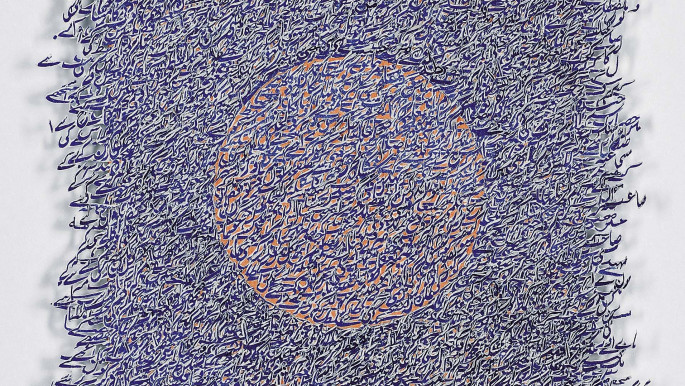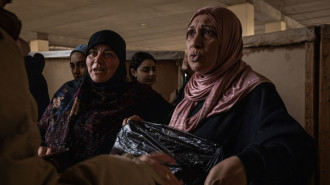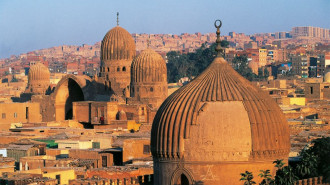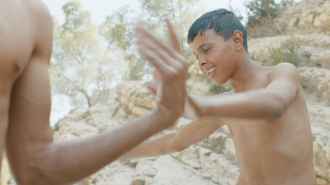Jameel2016: The when, where and who of Islamic art
Similarly, artistic traditions rarely ever die out entirely; rather, they evolve and adapt to the ever-shifting needs and desires of those who consume them.
This is precisely what has happened with Islamic art, as shown by the Jameel Prize, the fourth iteration of which opened this week at the Pera Museum in central Istanbul.
By jumping forward to the Islamic art of today, a series of key questions and answers about the nature of Islamic art emerge.
The idea behind the Jameel Prize is to bring attention to contemporary artists or designers whose work is in some way inspired by Islamic tradition.
The works must have been produced in the past five years, and the winning artist receives an award of GBP 25,000 ($36,000).
This prize is the only one of its kind. You might think that unsurprising; how many people, after all, honestly care about Islamic art, and how many fewer care about its contemporary interpretation?
However, you'd be wrong.
This year, nominations were received from more than 280 artists, hailing from more than 50 countries, including the first entrants from Afghanistan and Mali.
As Tim Stanley, senior curator of the Middle Eastern Department of the Victoria & Albert Museum and founder-curator of the Jameel Prize, puts it: "This is not about simple historicism - it's a response to the past, but relevant to our lives today."
Indeed, the V&A's role in setting up the prize makes sense, given the museum's history in collecting Islamic art since the 1850s as a means of educating Britain in the art of good design.
 |
This is not about simple historicism - it's a response to the past, but relevant to our lives today. - Tim Stanley |
 |
This is the first time that the Jameel Prize has opened outside of London, and the choice of the Pera Museum is inspired.
It's a terrible cliche to say that Turkey, and particularly Istanbul, straddles East and West, Asia and Europe, minarets and Martinis - but, as with many cliches, it exists because it's basically true.
Given everything that's happening at the moment, holding this event in Istanbul builds bridges and sends a powerful message - while also extending a hand to Turkey's art scene.
Since the prize began in 2009, it has travelled to a number of different locations around the world, including Beirut, Sharjah, Moscow, and, before the Syrian revolution, Damascus.
Opening the exhibition outside London was the obvious next step in this process, and in future years the exhibition's launch will alternate between the V&A and international partners.
| Read more: What we mean when we talk about Islamic art |
The power of script
The winner, as announced at the Pera Museum on Tuesday night, is Ghulam Mohammad, a young, softly spoken artist from Lahore who painstakingly liberates Urdu script from printed works and rearranges it in dazzling, intricate collages to create what he describes as a "miniature painting made with words".
The two-dimensional form of the printed word is rendered three-dimensional through the transformative act of freeing it from its original setting. Up close, his works are luminously beautiful, and he truly is a deserving winner.
This fascination with the power of script is strongly felt in works elsewhere in the exhibition.
Lara Assouad and Bahia Shehab use Arabic script and typography as a way of thinking about history, whether to document it - in Shehab's excellent A Thousand Times No - or to shed the script of the weight of its historical and religious associations - in Assouad's Modular Arabic Alphabet and Type Set.
 |
| Ghulam Mohammad liberates Urdu script from printed works and rearranges it in dazzling, intricate collages to create what he describes as a "miniature painting made with words" [Ghulam Mohammad] |
Rasheed Araeen, the octogenarian pioneer of British Minimalist sculpture, combines Arabic calligraphy with geometry in his visually arresting Al-GhazaliAl-GhazaliAl-GhazaliAl-Ghazali, referencing the 11th century philosopher and theologian al-Ghazali.
Another key theme among works shown this year is architecture. Shahpour Pouyan's Unthinkable Thought stands out as just one example, linking the built form - specifically, a series of domes from Iran, Italy, Germany, and elsewhere - with their patrons' desire to assert political power.
David Chalmers Alesworth, British-born but until recently resident in Pakistan, "intervenes" in worn Persian and Pakistani carpets by overlaying them with stitched designs of European gardens.
His Hyde Park Kashan 1862 shows a map of Hyde Park and South Kensington superimposed onto an Iranian carpet, with its own 'paradise garden' woven at its centre.
To these two visual elements, perhaps one could also add the idea of rupture, of the split between "then" (Islamic art) and "now" (contemporary art).
Istanbul-based Cevdet Erek's works combine all three elements, with his Ruler 100 Years (Calendar Revolution) examining the shift from Ottoman Turkish and Hijri (Islamic) dates to the Latin script and the Gregorian calendar, and his Sound Ornamentation a sonic response to modernist architectural form.
A final theme is that of storytelling. Wael Shawky and CANAN both aim to tell stories, whether historical (Shawky's Cabaret Crusades: The Path to Cairo, the second part of a film trilogy which tells the story of the Crusades using marionettes) or contemporary (CANAN's really quite daring Resistance on Istiklal and Bosphorus Bridge, which use Ottoman-style miniature paintings to retell key moments from the 2013 Gezi protests).
Both employ forms which, whether popular or elite, were used to record history in the Islamic world, and use these to reflect on the current state of things.
Islamic art
But what are the bigger questions which were promised at the beginning of this article?
The first is the question of when Islamic art is. It is fairly straightforward to argue that Islamic art, by definition, begins with the revelation of Islam in 622, but it is the end-point which is more difficult to define.
Most collections of Islamic art tend to just peter out at some point in the 18th century, with the possible exceptions of Iran and India, where curators are generally happy to put in later-produced works as crowd-pleasers.
The best argument for a cut-off point for Islamic art is probably 1918, where the end of the First World War brought about the rise of secular nation-states and consolidated European colonial rule of most of the Islamic world.
However, what makes the Jameel Prize so daring is that it rejects the idea that Islamic art ceased to be made nearly a century ago. Instead, it argues for Islamic art continuing to be made, an art of the contemporary world which acts in dialogue with tradition.
 |
What makes the Jameel Prize so daring is that it rejects the idea that Islamic art ceased to be made nearly a century ago. |  |
This follows into the next question; who is Islamic art? The presence of artists who are neither geographically, linguistically or religiously part of the Islamic world in the Jameel Prize shortlist - such as Lucia Koch, the Brazilian artist whose Showcase works are on display at the Pera Museum - also harks back to the history of Islamic art.
The Dome of the Rock, that most wonderful of early Islamic monuments, was decorated in part by Byzantine mosaicists; mediaeval metalwork from Mosul features Christian imagery; and the great Mughal emperor Akbar sponsored a Persian translation of the Hindu epic, the Mahabharata.
Islamic art, then, is not simply Muslim artists, and nor is it just Muslim patrons. Rather, it is art produced under the cultural influence of Islam, whether that is political (as in the past) or personal (as with the Jameel Prize).
Finally, the last question; where is Islamic art? Again, the Jameel Prize shows that this is not a geographical location.
History shows us that Islamic art could be made outside of what we currently think of as "the Islamic world", whether in Chinese blue-and-white ceramics or in Europe, where a variety of objects on different media were made in imitation of Islamic styles. Which, of course, brings us back to the V&A and its mission, from the very outset, to use Islamic art to inspire the very best of today's art and design.
Art historian William Greenwood was curator for Central Islamic Lands at the Museum of Islamic Art, Doha from 2011 to 2015. During this time, he was lead curator on three major exhibitions: Steel and Gold: Historic Swords from the MIA Collection (2013), Kings and Pawns: Board Games from India to Spain (2014), and The Tiger’s Dream: Tipu Sultan (2014).
He has also worked in several other areas of the art world, including journalism, auctions, museum consultancy and lecturing.
![Jameel Prize [Bahia Shehab] Jameel Prize [Bahia Shehab]](/sites/default/files/styles/image_345x195/public/media/images/1337AD4C-EF8E-4BEA-9211-53A4D8278CB0.jpg?h=d1cb525d&itok=jjZxA3Pd)
![Palestinians mourned the victims of an Israeli strike on Deir al-Balah [Getty]](/sites/default/files/styles/image_684x385/public/2024-11/GettyImages-2182362043.jpg?h=199d8c1f&itok=xSHZFbmc)


![The law could be enforced against teachers without prior notice [Getty]](/sites/default/files/styles/image_684x385/public/2178740715.jpeg?h=a5f2f23a&itok=hnqrCS4x)
 Follow the Middle East's top stories in English at The New Arab on Google News
Follow the Middle East's top stories in English at The New Arab on Google News


